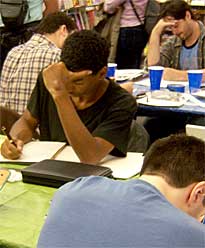
Comics pros take the dare at Jim Hanley's Universe in Manhattan, 24-Hour Comics Day 2007.
Some create in groups, others go it alone.
That means everything: Story, finished art, lettering, color (if applicable), paste-up, everything. Once pen hits paper, the clock starts ticking. 24 hours later, the pen lifts off the paper, never to descend again. Even proofreading has to occur in the 24 hour period. (Computer-generated comics are fine of course, same principles apply).
No sketches, designs, plot summaries or any other kind of direct preparation can precede the 24 hour period. Indirect preparation such as assembling tools, reference materials, food, music etc. is fine.
Your pages can be any size, any material. Carve them in stone, print them with rubber stamps, draw them on your kitchen walls with a magic marker. Whatever you makes you happy.
The 24 hours are continuous. You can take a nap, but the clock keeps ticking. If you get to 24 hours and you're not done, either end it there ("the Gaiman Variation") or keep going until you're done ("the Eastman Variation"). I consider both of these "Noble Failure" Variants and true 24 hour comics in spirit; but you must sincerely intend to do the 24 pages in 24 hours at the outset.
THE ONLINE VARIATION: The above applies to printed comics or online comics with "pages" but if you'd like to try a 24-hour Online Comic that doesn't break down into pages (like the expanded canvas approach I use in most of my own webcomics) then try this: At least 100 panels AND it has to be done, formatted and ONLINE within the 24-hour period!
At one hour per page, some treat the 24-hour comic as a minimalist exercise (i.e., how little can you put on a page and still have it be comics?), but I like to think of it in the opposite way: how much can you put on a page in an hour? If you think about it, the answer is a lot! Figuring six panels per page that's ten minutes per panel. Try it yourself. Draw a box about 3 inches wide, 2 inches tall, set a timer for ten minutes and see how much you can draw. You might surprise yourself.
As far as planning goes, you can think about it beforehand, but I recommend improvisation as the most satisfying route. Perhaps have some randomizer at startup (like a Pictionary or Tarot Card Deck or a child's picture book of household objects) to actually prevent you from knowing what the story will be about beforehand. The less you plan, the less likely you are to get frustrated.
Some have found the exercise is especially fun to do in big groups. Some even chronicle the food they ate, the music they listened to, etc. And of course, with the advent of 24-Hour Comics Day, you can join a really BIG group. [Just don't try to drive home afterward—get a ride!]
Alternately, doing it alone—though a bit bleak—can have a peculiar allure and can feel like a rite-of-passage, crossing-the-desert kind of thing. No, really. I'm serious! Oh, never mind....
My strongest suggestion is: Do it! It's fun, it's exciting, it's mind-altering, it'll teach you all kinds of cool stuff about yourself and best of all, it's only one day, so what have you got to lose?
When you're done, feel free to send me a photocopy (or link, in the case of webcomics), but it's no longer one of the rules and I won't be able to personally respond. For the first few years, I listed them all here on this site, but since the debut of 24-Hour Comics Day, there are just too many to list.
Scott McCloud
Box 115
Newbury Park CA 91319
[scott @ here]
Thanks, and good luck.